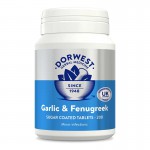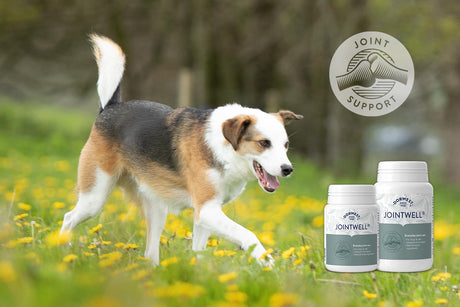We all know garlic so well that it seems almost irrelevant to need to talk more about it, but although it’s a commonly recognised food ingredient, not everyone knows its other properties, and then of course there is the question owners ask us about whether it really is safe to give to dogs. So this time we are going to give you some of the history of garlic as a medicinal plant, its valuable uses as a medicine for pets and then explain where the concern about its safety has come from, what the risks are and the facts as we know it.
History

So we’ll start with a little interesting background information on its history and use. Garlic is often known as the “king of herbs”, probably because it has been used for a wide range of ailments over thousands of years, with reports of its use right back to 2000BC. Garlic was brought into Great Britain in 1548, from the Mediterranean and in 1564 Lonicerus, a famed German professor and doctor, recommended its use in a range of skin diseases.
Louis Pasteur, the famous microbiologist, wrote in 1858 that garlic killed bacteria and he maintained it was effective even against some bacteria resistant to other factors. The antiseptic properties of garlic were confirmed in the keeping down of cholera in 1913, typhoid fever and diphtheria in 1918, and the French phytotherapist, Lekrek, used garlic as a preventive remedy with success during the great pandemic of influenza, the so-called ‘Spanish fever’, in 1918 following the First World War. Garlic was also famously used in the treatment of German soldiers during World War I, and although penicillin was already in use by the second World War, the Russian Red Army continued using garlic and it was apparently renamed there as Russian penicillin or just natural antibiotic.
As late as in 1944, the oily, colourless, unstable substance called allicin was isolated from garlic and later it was established that allicin has strong bactericide power. Even in gigantic dilutions of one in a quarter of a million allicin showed antibacterial activity against certain bacteria. In 1947, the chemical formula of allicin was determined.
As you can imagine over the years some interesting facts and stories have been associated with garlic – for example it is said that if you put a clove of garlic next to your foot, between your sock and skin, the garlic is detectable in your urine within about 15 minutes. That’s a real indication of its strong properties and probably its pungent aroma, but maybe not something we would all want to try. It seems unbelievable to us now, but during the epidemic of influenza in America during 1917 and 1918, people wore necklaces of garlic when going out in public – we can’t imagine that happening now but does show its wide use and acceptance as a medicine at that time. At the time when antibiotics and other pharmacy products did not exist, a bulb of garlic itself represented a whole pharmacy industry due to the broad spectrum of its use. Before antibiotics were discovered, garlic was used as the main antiseptic for treating wounds and there are stories of it being used widely in the trenches during the First World War as there were very few other substances available to kill bacteria and clean wounds. Maybe the smell of garlic was also preferable to the conditions and smells in those terrible places too.
As with most traditional herbal plants, garlic was almost ignored after antibiotics were discovered, particularly in the UK and USA where it mainly became just a food ingredient, although across the rest of Europe the tradition of using plants in medicine continued alongside the newly discovered drugs, and it still does so today. Garlic of course is both a food and a medicine but it has that in common with many plants which have a range of health giving properties as well as being good in cooking.
Its properties and use today
As far as its use in animals is concerned, there is good evidence going back over the centuries that it was, and still is, widely given to a range farm animals to both maintain health and treat ailments and of course it was also given to household pets as they became more popular and important in people’s lives. In some third world countries where modern medicines are hard to come by, plant based medicine is still the most common form of treatment and some years ago Dorwest sponsored some research on this in isolated African populations which makes fascinating reading.
Dorwest can’t go back quite so far in its history, but we do know that over the nearly 70 years that we have been producing medicines containing garlic, they have been continuously our most used and trusted products and although mainly given to dogs and cats, we have had customers who use our garlic based supplement (Garlic & Fenugreek Tablets) on many different species, ranging from budgies and reptiles to horses, goats and cattle. During this long time we have amassed a great deal of information on the use of garlic in various species and as part of our strict quality control we have also recorded any side effects or adverse reactions that may have occurred.

Garlic is multifunctional because of its wide and varied properties and as seen from its history its antibacterial properties are probably its most well known. Our Garlic & Fenugreek Tablets are one of our best sellers for 60 years, and a fundamental Dorwest herbs ‘staple’ product, packed full of natural active compounds to support general health and help keep your pet feeling their best.. Garlic and fenugreek are both known for their beneficial health properties; garlic provides supportive, soothing and cleansing effects, as well as helping to maintain the body's defences against parasites and infectious agents. Garlic is specifically known for its effect on the upper respiratory tract and so for coughs and the non-severe or acute respiratory conditions it is very helpful in bringing these under control. Because of its antibacterial and antiseptic actions it is also excellent to keep bad bacteria in the whole digestive system under control and because parasites and other unwanted invaders are repelled by its smell and action it is also very useful to keep a clean digestive system and so useful in parasite control. Garlic is nearly always best when used over a period of time, which may be a month’s course of tablets as a treatment for a specific condition, or daily as a maintenance to keep the system healthy. We find that the majority of our customers tend to use Garlic & Fenugreek Tablets this way as part of their everyday regime because of the benefits they see in their pets from this regular administration.
There are so many other properties of this wonderful herb that it would fill a whole book, and indeed there are books devoted to its use, but just some that may be of interest are its ability to lower blood pressure, cleanse wounds and abrasions when used externally and to stimulate the immune system and so increase resistance to infections. Our customers also tell us that they give it regularly for this reason, especially to dogs who regularly come into contact with others, for example at dog shows, agility events or simply when out walking in the park. These dogs seem to have a lower likelihood of picking up bugs from other doggie friends when they are given this medicine regularly and we notice this in our own dogs too.
Is it safe, what are the toxicity concerns?
So, we know garlic is a powerful and well used herb, but what about the current toxicity issue associated with giving it to dogs? We think this needs to be put into some perspective, not only taking its long historical use into account but also looking at the modern scientific evidence that is available.
There is strong evidence that onions affect the hæmoglobin in the blood and this links it to a form of anæmia, but there is less evidence that garlic has ever caused such a reaction when given at appropriate amounts. An article by Alexander Campbell, recent director of the Veterinary Poisons Information Service (VPIS) Medical Toxicology Unit, was published in UK Vet magazine in January 2007 and mentions garlic but the references given show that all the evidence refers to onions and that this is not new research but something that has been known about for over 20 years. Garlic has long been used as a safe medicinal plant in holistic medicine for people and pets and its therapeutic effects are recorded in many well researched publications and pharmacopœias. However, the safety of using garlic for dogs has again been raised due to it being a member of the Allium genus along with onions, shallots and lilies. Questions about the toxicity of garlic have been widely circulated on internet forums and as a result also in the pet and veterinary press. Indeed nowadays there are some vets who also recommend that clients do not give garlic to dogs, but this appears mainly to be simply from the reports in the media and of course in the main vets do not have the appropriate training or knowledge of plant medicine to make valued judgements on this.
There is a compound found in onions, called n-propyldisulfide, that can if given in sufficient quantities, cause oxidative damage to red blood cells, creating Heinz bodies and triggering the body to reject these cells from the bloodstream, causing Heinz-body anæmia and potentially even death. Although as far as we are aware there have been no fatalities among dogs in the UK. This same compound is also present in garlic but in smaller amounts. For a dog to develop Heinz-body anæmia, it is estimated that it would have to be given over 0.5% of its body weight in onions, and the equivalent of several whole bulbs of garlic. As red blood cells are constantly regenerated from the bone marrow, this amount of onion or garlic would have to be given on a repeated basis to cause permanent harm. This would mean that a 20kg medium sized dog would have to ingest 100g (3.5oz) of onions daily over a period of time for this oxidative process to begin the Heinz-body process and this is extremely unlikely, if not impossible, to be given in practical terms.
There was an ad-hoc study carried out in the Far East over ten years ago that is often referred to but as far as we are able to find out, the research and methodology was poor. We have been unable to find out some very basic questions on this study such as the purity of the garlic used in the study, what amount was given, over what period or how the amount to give was determined and what controls were used. It does seem that for this study large quantities of garlic, several bulbs, were introduced directly into the animal’s bodies over a long period. In short, the standards and conditions under which this study was carried out were not specified with regard to the material, dosage or other factors that would affect the results. We feel that this particular study has doubtful credence in fact and the enormous amount and method used to give garlic to dogs is very unlikely to occur in normal domestic situations.
So what facts do we know?
The substantiated facts on the use of garlic in medicines for dogs and cats is much easier to confirm. The most important fact is that there are two AVM-GSL authorised Veterinary Herbal Medicines in the UK containing garlic as the main active ingredient. We manufacture, supply and hold the medicines authorisations for both of these medicines and we are the only manufacturer of veterinary medicines containing garlic as an active ingredient in the UK, and we believe also the only one in Europe. These two medicines have been authorised (sometimes referred to as “licensed”) by the UK government’s Veterinary Medicines Directorate (the agency that oversees, approves and authorizes the use of all animal medicines in the UK) for nearly 40 years and these medicines have been in regular use for at least 60 years. The pharmaceutical section of the medicine dossiers lay down very specifically the quality and specification of the garlic used, and this has to be compliant with the requirements for garlic as a medicinal ingredient in the European Pharmacopoeia. This means that it is of a much higher quality, with a guaranteed allicin content and purity than the garlic used in foodstuffs or other unregulated supplements. However, it is the clinical part of the dossier required for a medicine to be authorised that is perhaps the most relevant to the owner giving this to their dog. In order for us, as the holder of the medicine licence, to be able to recommend its use for specific conditions and to sell and advertise it for use in these conditions, the clinical assessors who are all veterinary surgeons have to be satisfied that the medicine will treat the condition or ailment that it is to be used for and that it is not only effective but also safe for the species of animal that it is to be administered to when given in the recommended dosage. We have to provide reports from vets who use the medicine and these are assessed along with evidence of its use in dogs and cats, and in the case of a medicine with a herbal ingredient, its traditional long use is taken into account also. This is a very thorough and scientifically based assessment but it does not stop there.
Once a medicine has been authorised for sale, it is continually reviewed through pharmacovigilance procedures and inspections. This includes an assessment and review of the details of any Suspected Adverse Events (often referred to as adverse reactions or side effects) that may have occurred. This reporting is run by the VMD's Pharmacovigilance Unit and is used to collect information from veterinary professionals and the general public on suspected adverse reactions and lack of efficacy to all veterinary medicines including our herbal ones. As a manufacturer we also have to send in regular reports regarding every medicine’s on-going safety. The number of doses that have been given to dogs and cats during the time that our two garlic medicines have been authorised runs into millions and millions. The two medicines that we manufacture containing garlic sell over 1.5 million doses per year and our records show that for these the number of side effects or adverse reactions is just 0.00001% or one in every 10 million doses, and these are only suspected and not confirmed reports. Furthermore none of these suspected reactions have concerned any form of anæmia.
What plants really cause the most common cases of poisoning in dogs?
At the 2007 British Small Animal Veterinary Association Congress there was a lecture on Plant Toxicology and it confirmed that while onions are shown on the USA list of plants toxic to small animals, garlic does not feature. The plants that cause most poisoning cases dogs and cats, including fatalities, and often when only relatively small amounts are eaten are lilies, cannabis and daffodils and of course grapes and raisins which are extremely toxic but classified as foods rather than plants.
Nearly all medicines and many foodstuffs if given in sufficient quantities have the potential to be toxic and there are reports on fatalities being caused by some really common foodstuffs that we would not generally consider to be toxic, so it is the quantity rather than necessarily the plant species that needs to be considered. Because garlic has the potential to be toxic if given in large quantities the UK’s Veterinary Poisins Information Service cannot, quite rightly, describe it as categorically safe, so it is the mention in magazine articles and on the internet that is causing the enquiries to be made rather than any actual concerns about the safety of garlic being given to dogs when administered in the advised sensible amounts.
We really are the experts when it comes to herbal pet care
We believe that we are the only company in the world manufacturing authorised veterinary medicines with garlic as the active ingredient and who have a history of Suspected Adverse Events for them going back over many decades. We are confident that through their long use both our medicines containing garlic have not caused any adverse events. However we would emphasise that all medicines should only be administered at the recommended dosage as shown on the label. When given correctly their efficacy as a treatment for dogs and cats is acknowledged and confirmed by the VMD, the general public and the veterinary profession.
So you can use either our Garlic Tablets, for general health and regular administration, or our Garlic & Fenugreek Tablets with confidence although as always if you ever have any concerns about anything you give your pet or about its general health and well-being then you should always take veterinary advice.
© Dorwest Herbs Ltd 2018







